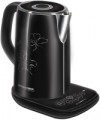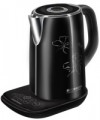Maintaining t° (kettle)
The ability to operate a classic kettle (see "Type") in the mode of
maintaining the water temperature — when the heated water is kept hot due to the operation of the heater at low power. For kettles, unlike thermopots, this mode is far from necessary, so its presence is indicated separately in the specs.
Control via smartphone
The ability to remotely
control the kettle from a smartphone, tablet or other similar gadget with a special application installed. The connection can be made via Wi-Fi or Bluetooth.
This feature does not only allow you to control the device from a distance, but often gives you more options than the classic control method. For example, special "chips" like a timer or thermostat can only be accessed through the application. In addition, the information about the operation of the kettle is transmitted to the application — for example, thermometer data, status (on/off), etc. Due to plenty of features, models controlled from a smartphone are often called
“smart kettles”. Their main disadvantage is their high cost.
Body shape
The general shape of the body of the electric kettle.
—
Conical. The most popular option: a body is wide at the base and tapering upwards. This form contributes to stability: the centre of gravity is maximally displaced downwards. However washing such a kettle from the inside may not be very convenient due to the relatively small size of the opening in the upper part.
—
Cylindrical. The cylindrical shape provides more or less the same width of the body at the base and at the top. With the same height and base diameter, such kettles hold slightly more water than conical ones; in addition, such a device is easier to clean due to the wide opening for the lid.
—
Inclined. The body which is inclined forward; the width of such a body is usually more or less the same over the entire height. Such kettles have an unusual, eye-catching appearance; in addition, it is easier to pour water from them — the device must be inclined at a smaller angle than with a cylindrical and even with a conical body. However, this option does not provide fundamental advantages over the same cylindrical shape, but it is more expensive, and therefore is not common.

